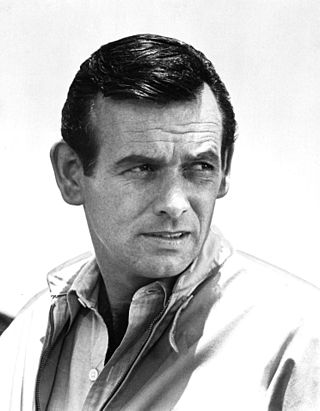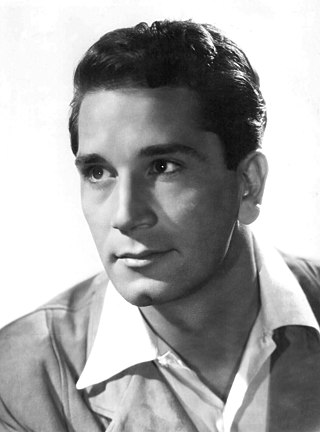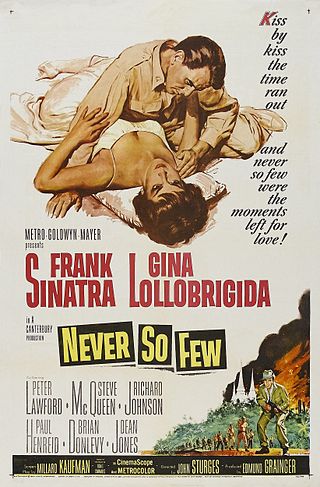
David Janssen was an American film and television actor who is best known for his starring role as Richard Kimble in the television series The Fugitive (1963–1967). Janssen also had the title roles in three other series: Richard Diamond, Private Detective; O'Hara, U.S. Treasury and Harry O.

Nicholas Peter Conte, known professionally as Richard Conte, was an American actor. He appeared in more than 100 films from 1939 through the 1970s, including I'll Cry Tomorrow, Ocean's 11, and The Godfather.

To Hell and Back is a Technicolor and CinemaScope war film released in 1955. It was directed by Jesse Hibbs and stars Audie Murphy as himself. It is based on the 1949 autobiography of the same name and is an account of Murphy's World War II experiences as a soldier in the U.S. Army. The book was ghostwritten by his friend, David "Spec" McClure, who served in the U.S. Army's Signal Corps during World War II.

Stafford Alois Repp was an American actor best known for his role as Police Chief Miles Clancy O'Hara on ABC's Batman television series.

Private's Progress is a 1956 British comedy film directed by John Boulting and starring Ian Carmichael, Peter Jones, William Hartnell and Terry-Thomas. The script was by John Boulting and Frank Harvey based on the novel of the same name by Alan Hackney.

John Francis Regis Toomey was an American film and television actor.

Don Haggerty was an American actor of film and television.

Don "Red" Barry, also known as Red Barry was an American film and television actor. He was nicknamed "Red" after appearing as the first Red Ryder in the highly successful 1940 film Adventures of Red Ryder with Noah Beery Sr.; the character was played in later films by "Wild Bill" Elliott and Allan Lane. Barry went on to bigger budget films following Red Ryder, but none reached his previous level of success. He played Red Doyle in the 1964 Perry Mason episode "The Case of the Simple Simon".

Never So Few is a 1959 CinemaScope Metrocolor war film directed by John Sturges and starring Frank Sinatra, Gina Lollobrigida, Peter Lawford, Steve McQueen, Richard Johnson, Paul Henreid, Brian Donlevy, Dean Jones, Charles Bronson and Philip Ahn, and featuring uncredited roles by renowned Asian actors Mako, George Takei and James Hong. The script is loosely based on an actual OSS Detachment 101 incident recorded in a 1957 novel by Tom T. Chamales. Sinatra's character of Captain Tom Reynolds is based on a real OSS officer and, later, sheriff of Sangamon County, Illinois, U.S. Navy Lt. Meredith Rhule.

Henry Rowland was an American film and television actor. He is remembered for his role as Count Kolinko in the Zorro television series.

Willis Ben Bouchey was an American character actor who appeared in almost 150 films and television shows. He was born in Vernon, Michigan, but raised by his mother and stepfather in Washington state.

One Minute to Zero is a 1952 American romantic war film starring Robert Mitchum and Ann Blyth, set during the opening phases of the Korean War, and produced by Howard Hughes as his last film as producer. Victor Young's score for the film includes the first appearance of "When I Fall in Love", as the instrumental titled "Theme from One Minute to Zero". The film showcases the contributions of the U.S. Army and U.S. Air Force, the South Korean Army, the United Nations, the British Army and the Royal Australian Air Force during the early days of the Korean War. The effects of air power in the Korean War were also vividly depicted through the use of combat footage.

John Crawford was an American actor. He appeared in a 1961 episode of The Twilight Zone, called "A Hundred Yards Over the Rim", and in several Gunsmoke episodes. He had a key role in the 1975 film Night Moves, a crime thriller starring Gene Hackman, played the mayor of San Francisco in 1976's The Enforcer and the third Dirty Harry film featuring Clint Eastwood, as well as the Chief Engineer in Irwin Allen's classic 1972 box-office smash and disaster-film epic The Poseidon Adventure.

Joe Sawyer was a Canadian film actor. He appeared in more than 200 films between 1927 and 1962, and was sometimes billed under his birth name.

Francis Thomas Sullivan, known professionally as Frank Sully, was an American film actor. He appeared in over 240 films between 1934 and 1968. Today's audiences know him best as the dumb detective in the Boston Blackie features, and as the foil in many Three Stooges comedies.

Douglas Henderson was an American film and television actor.

William Tyler McVey was an American character actor of film and television.

Robert Francis Hoy, was an American actor, stuntman and director.

Richard Stapley, also known by the stage name Richard Wyler, was a British actor and writer.

Walter Sande was an American character actor, known for numerous supporting film and television roles.



















